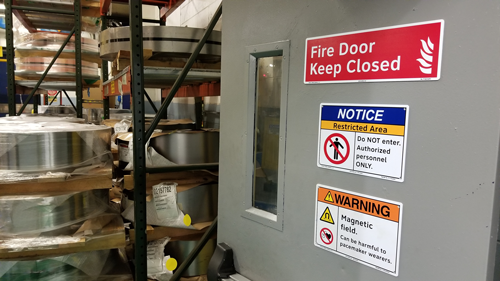Safety Management System Components
Posted by Clarion Safety Systems | 10th Aug 2018

How
can your business develop an effective safety management system?
There's no doubt today's business world is vastly different from what it was 10 years ago, driven by innovative technology and ever evolving regulation. Still, some things simply don't change
– particularly when it comes to keeping workers safe.
It's vital to communicate about protective measures and proper procedures in the workplace when hazards are present, so all workers can feel safe and stay free from injury in the setting that's such a large part of their lives. While certain aspects of safety may be straightforward, balancing compliance around the communication of hazards while taking into account elements of safety that are unique to a specific industry or business can make even the most obvious solutions seem complex.
How a safety management system can help your organization
A holistic
and streamlined safety management system (SMS) helps communicate unique hazards
and ensure buy-in across the team regarding
why the components of safety management is important. Every organization is different, so no two safety management plans will be truly identical. But key elements, which we'll examine
below, should be present across all of them.
Determining type and degree of risk
Before your
organization can get to work on a truly effective safety strategy, it's
critical to identify which protections you need. What are the risks at your
facilities? How serious are they, and what's the likelihood of their
occurrence?

All of these questions and others are what a comprehensive risk assessment seeks to answer. If your staff has experienced – and, if possible, trained – members with knowledge of workplace safety, they may be able to run point on this action. That said, the best evaluation of this kind will come from a dedicated third party safety organization, one capable of viewing your company's unique scenario with clear and totally objective eyes. Such personnel can identify every point of risk at your facility and make suggestions regarding how to treat all potential issues.
Existing guidelines and regulations as a baseline
The best way
to approach the construction of a safety management plan is to begin with
existing regulations – not simply those enforced by governments, but also the
guidelines of best practice voluntary consensus standards, like ANSI and ISO.
Using multiple systems as guidebooks can ultimately provide a more
comprehensive set of details upon which to base your company's own safety
system.
- ISO 45001:2018 is key among these, as this standard – Occupational health and safety management systems – Requirements with guidance for use – codifies the organization's approach to workplace safety and wellness. Replacing its predecessor, OHSAS 18001, it also took inspiration from various national regulations as well as systems from peer organizations, like ILO-OSH 2001 from the International Labour Organization.
- ANSI Z10, which sets forth a blueprint for devising and implementing safety systems with full buy-in from management to entry-level employees, serves as an excellent guide to the nuts-and-bolts realities of worker protection. Notably, periodic review is one of its vital components, which is in keeping with the continuing improvement principle of the management systems approach.
- OSHA regulations and guidelines such as the "Recommended Practices for Safety and Health Programs," and their counterparts elsewhere in the world, can also provide valuable background information. Notable international standards include the European Commission product safety rules and the European Agency for Health and Safety at Work guidelines.
Looking at worldwide standards is especially necessary for companies with factories or facilities outside the U.S. Achieving compliance with government regulations should not be where your organizational commitment to safety ends, however. Choosing to do that, regardless of your intent, will signify to at least some of your employees that the business is upholding safety procedures as a formality, rather than as something in which all of the company's chief stakeholders and management staff truly believe. The way that you present safety issues to the workforce and discuss them will loom large in how individuals treat the matter in their day-to-day responsibilities, and by extension, in the broader success of companywide safety initiatives.
Visual aid: The power of quality signage and labeling
Engaging in
open conversation about safety issues with workers, such as through periodic
informal seminars, and documenting a written policy that covers every potential
risk your business knows it can experience, are both important to an effective
SMS. These will be informed by the risk assessment performed beforehand.
But these aren't tactile actions, per se. Considering thatvisual learners comprise 65 percent of the population, according to the Social Science Research Network, objects employees can see, like signs and labels, can more effectively communicate safety principles on a daily basis. Signage actively emphasizes a workplace’s safety culture in a prominent, visual way while also boosting the effectiveness of safety training by reinforcing safe behaviors. At the same time, from a big picture perspective, it can help to maintain compliance and risk communication objectives as well as be part of continuous improvement initiatives in terms of setting a process for periodic review and upgrades – a key aspect of the management systems approach to safety.
It's imperative to consider every aspect of these visual-aid products. ANSI's standard comes into play here as a valuable tool due to the details it provides, as mentioned above. In addition to its categorization of warning types for labels and signage (SAFETY INSTRUCTIONS, DANGER, WARNING, NOTICE and CAUTION), ANSI Z535 also provides guidance on colors and text. Signage or labels and their symbols must be easily visible and comprehended – hence the common, consistent use of specific shades of red, orange, yellow, blue and green.
Regarding size, there must be enough room for the sign or label to feature a primary warning, as well as all necessary information regarding the likelihood, specific dangers and instructions on what to do should an accident occur. Last but not least, it's vital to place these safety products in areas where they're optimally visible (particularly for wayfinding and emergency-exit purposes), with the worker's viewing distances kept in mind.

Combining all of these components into a management system helps ensure businesses encourage and develop a culture of safety awareness that is not only compliant but also inclusive. Ultimately, risk reduction and accident prevention can improve morale and boost the bottom line.
See how Clarion can help your organization with workplace safety communication challenges and gaps . From risk assessment to sign assessments to customized solutions, we’re here to help.
